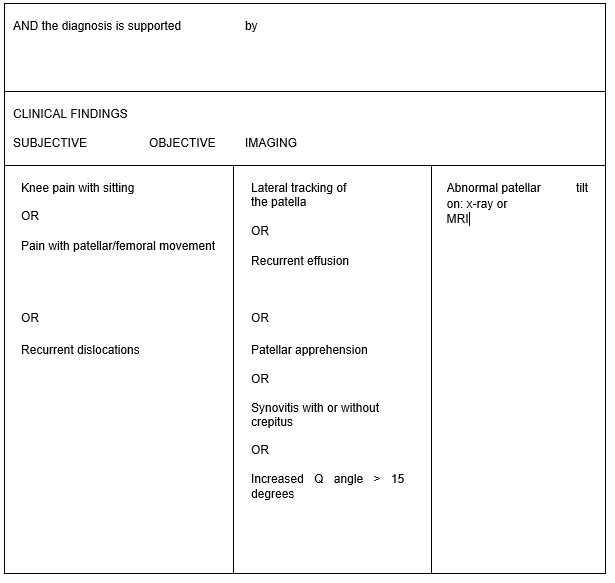New York State Medical Treatment Guidelines for
Retropatellar Pain Syndrome in workers compensation patients
The New York State workers compensation board has developed these guidelines to help physicians, podiatrists, and other healthcare professionals provide appropriate treatment for Retropatellar Pain Syndrome.
These Workers Compensation Board guidelines are intended to assist healthcare professionals in making decisions regarding the appropriate level of care for their patients with ankle and foot disorders. The guidelines are not a substitute for clinical judgement or professional experience. The ultimate decision regarding care must be made by the patient in consultation with his or her healthcare provider.
Description / Definition of Retropatellar Pain Syndrome
Retropatellar diseases are linked to the patellofemoral mechanism’s discomfort and resulting weakness and instability. Retropatellar Pain Syndrome may include patellofemoral arthrosis, chronic quadriceps tendonitis, distal patellar tendinitis, and symptomatic plica syndrome.
Mechanism of Injury for Retropatellar Pain Syndrome
Retropatellar Pain Syndrome may be connected to fractures, infection, connective tissue disorders, recurrent patellar compressive stresses, shearing articular injuries, and patellar subluxation or dislocation.
Specific Physical Findings of Retropatellar Pain Syndrome
Patients complain of discomfort that interferes with everyday activities and job duties, including pain, instability, and tenderness.
Physical examination findings may include atrophy of the quadriceps muscles, retinacular soreness, pain with patellar compressive range, positive patellar glide test, and retinacular apprehension. Increased Q angle, rotational lower extremity joints, ligament elasticity, and effusion are possible associated anatomical findings.
Diagnostic Testing Procedures
- Diagnostic Testing Procedures Radiographs
Diagnostic Testing Procedures Radiographs is recommended clinically appropriate in a subset of patients. - CT or Bone Scan
- CT or Bone Scan are recommended in very select patients.
- MRI
MRI is not recommended as it rarely identifies pathology. - Non-Operative Treatment
Non-Operative Treatment is recommended clinically appropriate in a subset of patients
Surgical Indications of Retropatellar Pain Syndrome
Dislocation of the patellar tendon, quadriceps tendon rupture or avulsion, fracture, or symptoms that do not improve with conservative treatment.
On the long-term effects of surgical treatment for anterior knee discomfort, there is relatively little information. Following the failure of a thorough rehabilitation programme that included quadriceps strengthening, surgical intervention should be taken into consideration.
Operative Treatment of Retropatellar Pain Syndrome
Operative Treatment of Retropatellar Pain Syndrome is recommended in select patients as clinically indicated.
Indications: dislocation of the patellar tendon, quadriceps tendon rupture or avulsion, fracture, or symptoms that do not improve with conservative treatment.
On the long-term effects of surgical treatment for anterior knee discomfort, there is relatively little information. Following the failure of an extensive rehabilitation programme that included quadriceps strengthening, surgical intervention should be taken into consideration.
Note: Only after four to six months of conservative therapy should retinacular release, quadriceps reefing, and tibial transfer procedures be taken into consideration.
Post-Operative Therapy
Therapy; bracing
Therapy; bracing is recommended
Table 7: Retropatellar Pain Syndrome

What our office can do if you have Retropatellar Pain Syndrome
We have the experience to help you with their workers compensation injuries. We understand what you are going through and will meet your medical needs and follow the guidelines set by the New York State Workers Compensation Board.
We understand the importance of your workers compensation cases. Let us help you navigate through the maze of dealing with the workers compensation insurance company and your employer.
We understand that this is a stressful time for you and your family. If you would like to schedule an appointment, please contact us so we will do everything we can to make it as easy on you as possible.

Dr. Nakul Karkare
I am fellowship trained in joint replacement surgery, metabolic bone disorders, sports medicine and trauma. I specialize in total hip and knee replacements, and I have personally written most of the content on this page.
You can see my full CV at my profile page.
